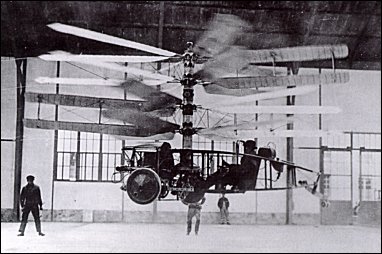
| Pescara No.3 1955 - project |  |
 |

| Pescara No.3 1955 - project |  |
 |
|
It is unfortunate that more complete records have evidently not survived of the later Pescara helicopters, for despite their apparent clumsiness they represented for their time an important step forward in helicopter design technology that deserves recognition. The Spanish Marquis Raul Pateras Pescara built his first helicopter in Barcelona in 1919-20. It was a clumsy machine, weighing some 600kg without fuel or pilot and powered by a 45hp Hispano engine. Each of the 2 co-axial rotors had a diameter of 6.40m and was made up of 6 biplane pairs of blades giving a total of 24 lifting surfaces, but the little Hispano was not powerful enough to raise the machine off the ground. A modified form of this aircraft, with a 170hp Le Rhone rotary engine, did just get off the ground in May 1921, but it was far from being a stable or satisfactory design. In 1922 Pescara moved to France, where the No.2 did succeed in rising some 1.5m during tests carried out for the Service Technique de I'Aeronautique. Pescara's most successful helicopter was the No.3, which was built in 1923 and by January 1924 was capable of making flights of some 10 minutes' duration. The same co-axial rotor system was employed, larger twin rotors each with 4 pairs of blades turning around a 'totem pole' rotor mast. A 180hp Hispano-Suiza engine, for which the Lamblin radiator was situated at the rear of the craft, provided the power. Although a heavy and cumbersome machine the Pescara No.3 was a simple design when compared with its closest contemporary, the Oemichen No.2, and makes an interesting comparison with the Breguet-Dorand of some ten years later. On 18 April 1924 Pescara flew the No.3 at Issy-les-Moulineaux for a distance of 736m, handsomely beating the record set up by the Oemichen only the day before. The significance of this achievement lay in the fact that Pescara's machine, unlike the Oemichen or any other rotorcraft up to that time, did not rely on conventional propellers rotating in the vertical plane to give the aircraft forward motion. Instead, the pitch of the 16 lifting surfaces could be altered in flight by warping them, and the rotor head could be tilted to give the blades a degree of forward thrust. The speeds thus achieved were extremely modest, but the Pescara No.3 exhibited the first convincing demonstration of the principles of cyclic and collective pitch control. Autorotation of the rotors was also provided for in the event of engine failure. Reference is made in some quarters to the Pescara No.3F, which was possibly a modification of the No.3 and not a new machine. This appeared in the early part of 1925 and had a 250hp engine, with a cut-down propeller fulfilling a cooling function only. It offered no great improvement over the No.3, and later that year Pescara returned to Spain and entered the motor car industry. He seems to have been discouraged from further serious helicopter development by the emergent success of Cierva with the autogiro, though he was associated with the little French-designed Pouit S-4 later in the 1920s. K.Munson "Helicopters And Other Rotorcraft Since 1907", 1968
Pescara's No. 3 machine, completed in 1923, used four 7.2m diameter 4-blade biplane rotors and no other propulsion mechanisms: the pitch of the 16 lifting surfaces could be altered in flight by wing warping. This was the first credible use of cyclic and collective pitch control, the essential ingredients of a helicopter. The rotor hub could be tilted for some measure of forward motion, but speed was only about 13km/h. This slow speed was one of the main reasons that the early "helicopters" used auxiliary propellers for forward propulsion. In September 1923, Pescara almost became the first person to complete a 1km circuit, but the machine crashed and was severely damaged. The next spring, four days after Oemichen's first FAI distance record, Pescara doubled it to 736m.
|